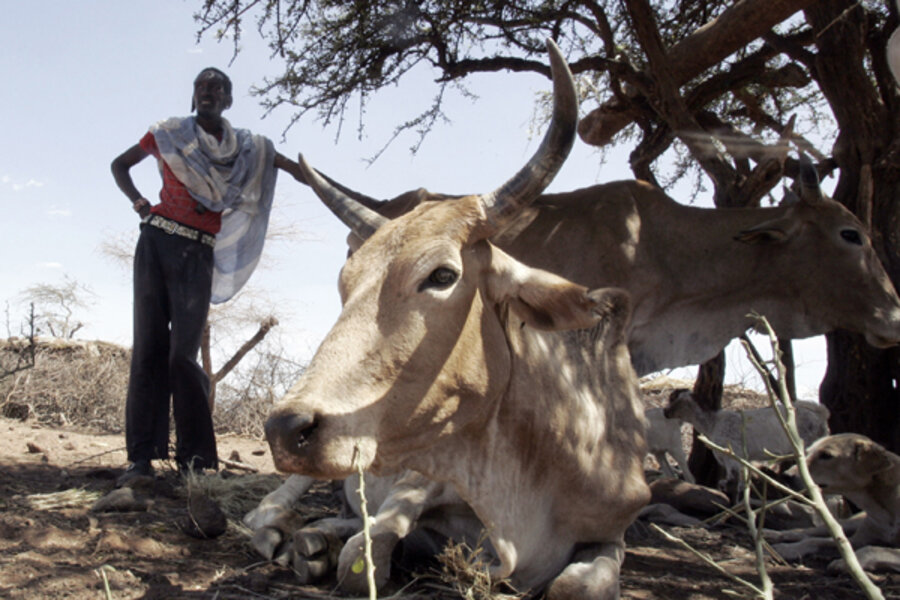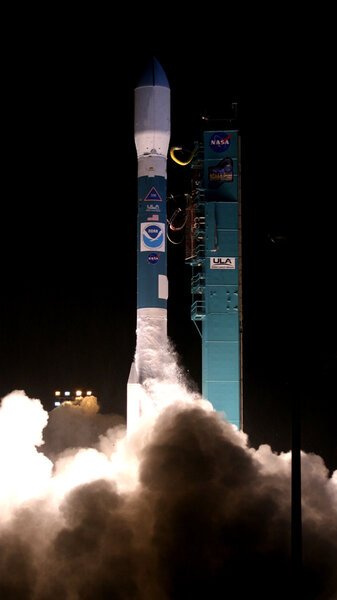Farm aid from space
Dusty northern Kenya doesn't look like a laboratory, but across its dry plains, cattle herders are pioneering a new way to fend off poverty and teaming up with unlikely partners – insurance agents.
The two groups have been brought together by the International Livestock Research Institute (ILRI), headquartered in Kenya's capital, Nairobi. A few years ago, scientists at ILRI wondered if a new innovation, called weather-indexed insurance, might help impoverished cattle farmers survive the loss of their cows during times of drought.
Weather-indexed insurance has been around for about six years. Like all insurance, the idea is to mitigate risk. Think of homeowner's insurance: A homeowner pays premiums so that, if a pipe bursts, the insurance company will reimburse her – after they've verified the damage, of course.
For the cattle, camel, and goat herders in Marsabit, a dry part of Kenya that shares a border with Ethiopia, animals are assets. Their sale can bring the income a family needs to survive, and a big herd, like a big house, is a store of wealth that can be useful collateral for credit, which analysts often say is key to pulling people out of poverty. At minimum, losing a cow is a devastating financial blow.
That's the kind of risk that insurance can defray, but insurance agents aren't going to travel to Marsabit to verify cattle deaths.
"We really wouldn't have even begun … a traditional [insurance] process. It was very clear for us at the onset that it wouldn't work," says Andrew Mude, chief scientist with ILRI.
Enter weather-indexed insurance, which changes the way the damage is verified for everything from cattle to crops.
"The idea with an index is, instead of providing a payout based on crop loss, you provide a payout based on something you can measure independently," says Dan Osgood, associate research scientist at the International Research Institute for Climate and Society at Columbia University.
Data gathered by 'moving stars'
In Kenya, they're measuring something slightly different. Mr. Mude and his team use the Normalized Difference Vegetation Index, or NDVI. "This is the measure of the greenness level on the ground," says Mude. "It's a very good predictor for us of ... the nutrition available for livestock," which eat the green vegetation.
The index is maintained by NASA, which has been using satellites to take pictures of the area since 1980. Such a long track record of data allowed Mude to test what seem, at first, like simple hypotheses: Does drought correspond to less greenery, and less greenery to high rates of cattle deaths?
"It certainly wasn't a given," Mude says. "If the relationship was not strong, then the index would not have value." But the tests worked, and the data became a proxy for livestock mortality: Insurance companies could use the proven relationship between vegetation and cattle deaths to build a complex formula that allows them to offer policies with affordable premiums to herders. For $10, a farmer in the driest part of the district can insure one cow. If grass levels fall below a certain point, the herder gets a payment of $200 per insured cow. Mude expects herders to insure about 50 percent of their herd in this pilot year.
This sidesteps the biggest problem of any insurance program: the moral hazard.
"If you're a farmer and you have [traditional] insurance," Mr. Osgood says, "you have an incentive to let your crops do badly, and the insurance company has to be very good at measuring how your crops are doing and making sure you're not letting them do badly."
But rainfall or vegetation data are objectively verifiable, reducing if not eliminating the possibility of cheating.
Weather-index insurance has its own challenges. One of the biggest is designing a policy people will buy; most insurance programs for crops have premiums ranging from $2 to $10. In pilot programs in Tanzania, Malawi, Ethiopia, Rwanda, India, and other countries, varying partnerships of governments, nonprofits, academics, and insurance companies have been working on creating insurance packages that are comprehensible and attractive to rural farmers or herders.
ILRI created a game to illustrate the benefits of insurance to the Kenyan herders they hoped would become customers. The herders appreciated the idea, but they wanted to know where this objectively available data came from.
"You imagine that satellites are quite a foreign concept," says Mude. But one of his trainers made a key analogy. "These are populations who understand the stars very well, who use the stars to help them guide their movements and so on. And so they are very aware that there are stars that move around at night – what they call 'stars,' in quotes – that are different from permanent stars. We let them know these moving stars are satellites taking pictures."
Counting raindrops vs. days of drought
In a pilot crop insurance program in Rwanda, the lessons went the other way. MicroEnsure, a company specializing in insurance products for the poor, created a rainfall-based insurance program for Rwandan tomato farmers. If it failed to rain a certain amount in January, February, or March, the farmers would get a payout. The amount changed every month, depending on how much rain agricultural scientists felt a tomato crop would need at that point in its growth cycle.
But the measurement system isn't perfect. It might rain in just two days the 100-milliliter minimum for all of January. The next 29 consecutive days without precipitation would likely kill the plants, but no payout would be made, since the rain threshold had been met. This was a problem the farmers recognized immediately, says Shadrek Mapfumo, vice president of agriculture insurance at MicroEnsure.
"The farmers told us, 'Why don't you look at how many days there have been with no rain?' " he says. "That's the kind of insurance they will be expecting when you are covering them against the risk of prolonged dryness."
If Africa is a land of lessons, India has been the laboratory for applying them. When MicroEnsure experimented with a policy based on the number of dry days, rather than monthly minimum rainfall, the demand for insurance in one town increased sixfold, from 4,000 customers to 25,000.
India is also the first place where weather-index insurance has looked to be more than a promising experiment.
"India has become a commercial market," says Juerg Trueb, a managing director in charge of environmental and commodities markets at reinsurance giant Swiss Re. The company's India premiums have grown from "a few hundred thousand dollars in 2004 to $100 million" expected this year, he says.
Meanwhile, the policies might help farmers fend off poverty. Crops insured against loss can be used as collateral for loans, and loans can be used to buy better seeds or invest in equipment. A combination insurance and loan pro-gram in Malawi helped MicroEnsure's clients increase yields by up to 200 percent, says Mr. Mapfumo.
"Because of that, we found that some of them were even able to buy new assets," he says. "One of our clients, the year before we had him, he was living in a mud house. The following year, he was able to build a structure with a corrugated iron roof. It really remade his life."






